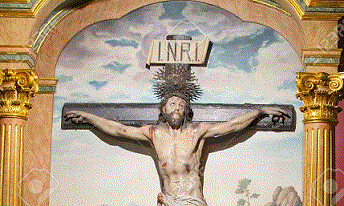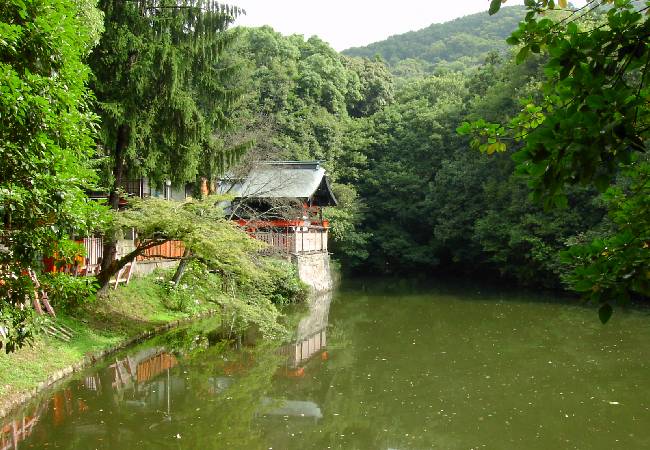|
Legend tells us that Fushimiinari shrine was founded by the Hata clan in 711A.D.
According to the Yamashiro-No-Kuni Fuudoki (The regional chronicle of the province of Yamashiro), Mr.Iromu Hata
shot an arrow at a target made of rice cake. Upon impact, the rice cake turned into a white swan which flew towards
the Inari Mountain. Rice paddies formed and rice grew at the back of the Inari Mountain where this white swan landed, and
the growth of rice was believed by the people then as a manifestation of God. It was said that the shrine's name of Inari
is formed the clipping of the Japanese word, "Inenari" which means Ine (Rice) and Nari (Grow). And this god became to be
known as the God of "Productiveness of the Grains" and "Prosperity in Business". However, it is said that this was an after-mentioned explanation of connecting rice because Kukai(Kobo Daishi) assigned the word Inenari to the original name Inari. Some historians have attempted to link Inari to ancient Christianity and explained it as follows. The Hata clan, founder of Fushimiinari shrine, was the ethnic group that migrated to ancient Japan with tens of thousands of people around the 3rd century. Their cultural and technological prowess greatly influenced ancient Japan from that time onward. Despite such a large-scale migration, the clan integrated quite amicably into the society as there were no records of conflicts occurring in various parts of Japan during this time.  Their origin has been hypothesized to be from Central Asia with an ancient Eastern Christian character,and INARI was most probably derived from -INRI-
(IESVS NAZARENVS REX IVDAEORVM:Jesus the Nazarene, King of the Jews).
INRI is the Latin inscription which the Roman army placed on the cross on which Jesus was executed.
Their origin has been hypothesized to be from Central Asia with an ancient Eastern Christian character,and INARI was most probably derived from -INRI-
(IESVS NAZARENVS REX IVDAEORVM:Jesus the Nazarene, King of the Jews).
INRI is the Latin inscription which the Roman army placed on the cross on which Jesus was executed. Unlike the other Japanese gods, Inari-Okami (Inari God) is the only god and most probably due to the influence of ancient Christianity,has no associated idols. In addition, the Fushimi Inari trademark of red Torii is reminiscent of an episode of Exodus in the Old Testament. As directed by God to protect firstborn sons from being slaughtered, angels instructed His people to paint the door frames and the lintel of the entrance gate in red with blood of lamb(resemble by red Torii). The shrine established here is the general headquarter of all the other inari shrines which number about 40,000 shrines in the whole of Japan. The fragrant smell of baked rice crackers in the shape of fox face and grilled sparrow and quail floats in the air at front entrance of the Shrine (Monzen), and many souvenir stores are within the compound of the shrine. The famous Japanese Buraiha, also known as "decadents" in the west, author Ango Sakaguchi is known to have said "I can't bear to live in Tokyo anymore." in1955 A.D., he thought "Oh. I have a good idea. I have to go to Kyoto immediately." Then he stuffed about a thousand sheets of manuscript paper into his small trunk and went to Kyoto. He stayed at a lodge in the Fushimiinari area and wrote the novel of "Koto (The old capital)". He described the Fushimiinari area in this novel as the most affordable and the most convenient place in the city of Kyoto. There were no electric refrigerators yet at that time, and many stores in the city were closed during the New Year holidays. But most of the stores in the Fushimiinari area were opened to serve the many believers who were visiting the Fushimiinari Shrine to offer New Year Prayer. So he thought Fushimiinari area was the most convenient place in Kyoto. There are many historical stores and restrants in front of the shrine. The Japanese food restaurant "Tamaya" in front of the JR Inari station is a long-established restaurant since 1616 A.D. Kogoro Katsura ,who was the famous activist during the last days of the Edo period, took a meal at this restaurant on March,1869. Though it was once used as the auberge by the worshipping visitors of Fushimiinari Shrine, it's recently being used mainly as a restaurant. The main hall of Fushimiinari Shrine built at about 1467(The period of the Onin era revolt)is designated as a Japanese Important Cultural Asset. Its roof is called "Uchikoshi Nagarezukuri" and it's curved-very beautiful and heroic. When you climb up the stairs from the main hall, you'll be greeted at the end by the Torii gates that lined up like a scarlet tunnel. The ensuing route is then divided two sections at the "Senbon torii (A thousand torii)".  The elevator from the main hall to the Thousand Torii for the exclusive use of wheelchairs was installed in April 2020.
The elevator from the main hall to the Thousand Torii for the exclusive use of wheelchairs was installed in April 2020.After going through this Senbon torii you will reach the "Okunoin (Inner sanctuary)". There is a stone called "Omokaru Ishi (The heavy or light stone) at the Okunoin. Legend has it that if you are able to lift this stone and feel it to be lighter than your thought, your wish will come true. Okunoin is not the last destination of the worship of Fushimiinari shrine. It is the starting point of Inariyama (Inari Mountain) pilgrimage course via Kumatakasha (Bear and hawk) sanctuary,Mitsutsuji (Trifurcated roads) and it also has good view of Yotsutsuji (Crossroads). And there are more sanctuaries like as Ichinomine (The first peak),Ninomine (The second peak), San-nomine(The third peak) and others. According to the old Japanese essay "Makuranosoushi (The Pillow Book) " , worshipping while trekking around the Inari mountain was already performed during Heian Period (from 794 A.D.). "Makuranosoushi" was written by Seishonagon (966-1025 A.D.) and considered to be one of the most famous old essay in Japan. A short excerpt of her essay about the Inari Mountain journey is as follows. "Though I had made up my mind to climb the Inari Mountain to worship, I felt very painful even to climb up to the middle sanctuary. It distressed me a lot to find out that so many people who were initially behind me easily overtook me and soon praying in the Inari Sanctuary at the top of the Inari Mountain way ahead of me." When you climb from the "Okunoin (Inner sanctuary)" for about 10 meters, there is a pine tree called "Neagari Matsu" which is believed to cure the disease of the lower back and the knee. "Neagari Matsu" is the pine tree whose roots reached out above the ground. Furthermore "Neagari" sounds similar to "A rise in price" in Japanese language. So many stockbrokers worship this pine tree. If you proceed further while keeping an eye at the cypress forest that appears and disappears in the scarlet Torii gates and valley below to your left, you will eventually arrive at a stone stairway and the "Kumataka Sha (Kumataka sanctuary)". Then you can see the stone monuments called "Otsuka" on your right. These were dedicated by the people who worshiped their personal Inari god. It is said that there are about 10,000 such stone monuments all over the Inari Mountain. Behind the "Kumataka sanctuary" there is a pond even at such a high place, and this pond is known as "Kumataka-ike (Bear and Hawk pond)" , "Shin-ike (New pond)" or "Kodamaga-ike (Echo pond)". Shin-ike (Meaning "New Pond")  The legend has it that your wish will come true in the direction where the echo returned when you clapped your hands toward the pond,
and this is reason for the name "Echo pond".
It is said that the pond has been managed and operated under strict village stipulations as an agricultural water source.
The legend has it that your wish will come true in the direction where the echo returned when you clapped your hands toward the pond,
and this is reason for the name "Echo pond".
It is said that the pond has been managed and operated under strict village stipulations as an agricultural water source.When you advance further, you arrive at the "Yotsutsuji (Crossroads)" via the "Mitsutsuji (Trifurcated road)". You can take a rest or have a light meal at the old store of "Yotsutsujitei" or "Nishimuratei" in the "Yotsutsuji (Crossroads)" while enjoying spectacular scenery around. You may even want to go on to the next pilgrimage course from here,via "Ousugi sanctuary","Ganriki sanctuary","Yakuriki sanctuary,"The first peak", "The second peak" and "The third peak". The stairway on the left from the "Yotsutsuji" is a part of the Higashiyama Trail and it's a great hiking course in eastern Kyoto. You can go to The Sennyuji temple via this way. Thanks to Mr. D.M. |
|